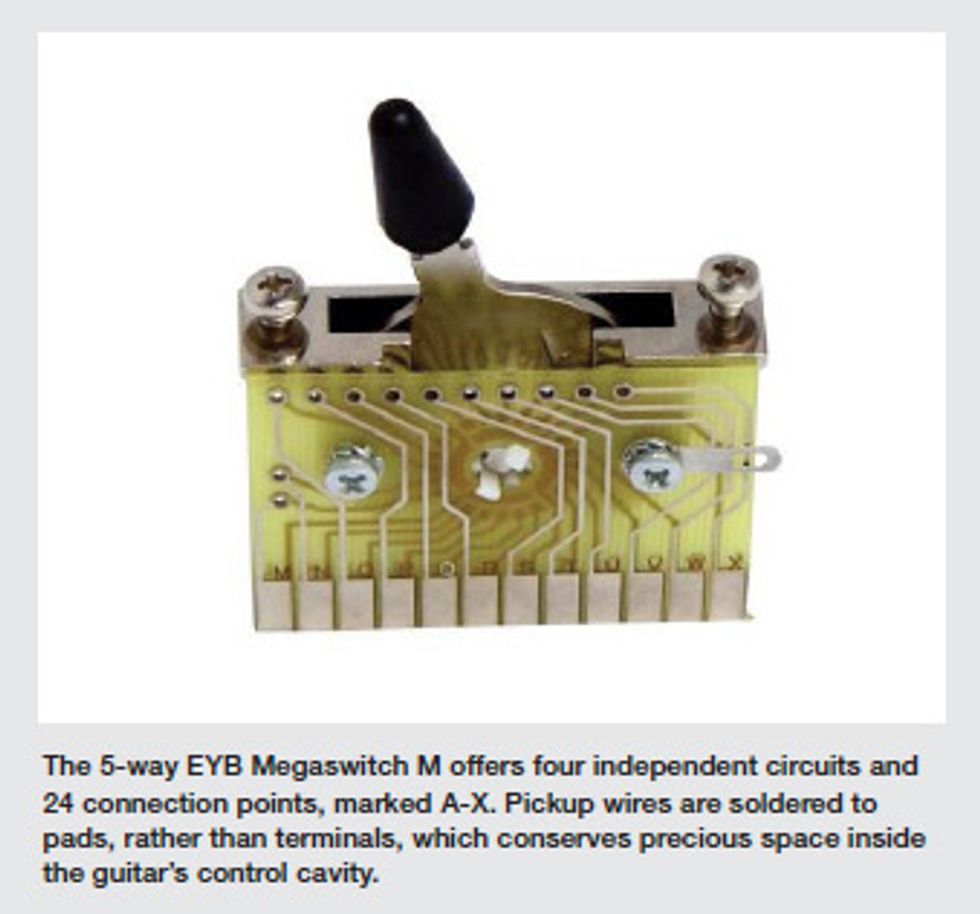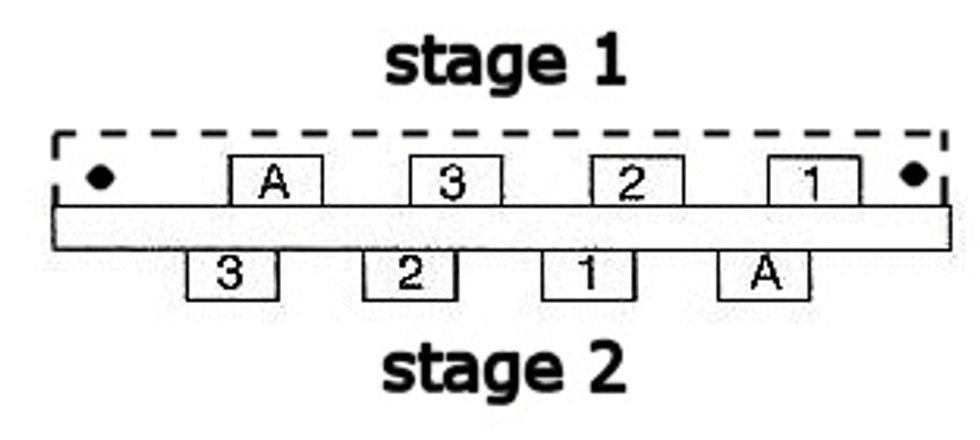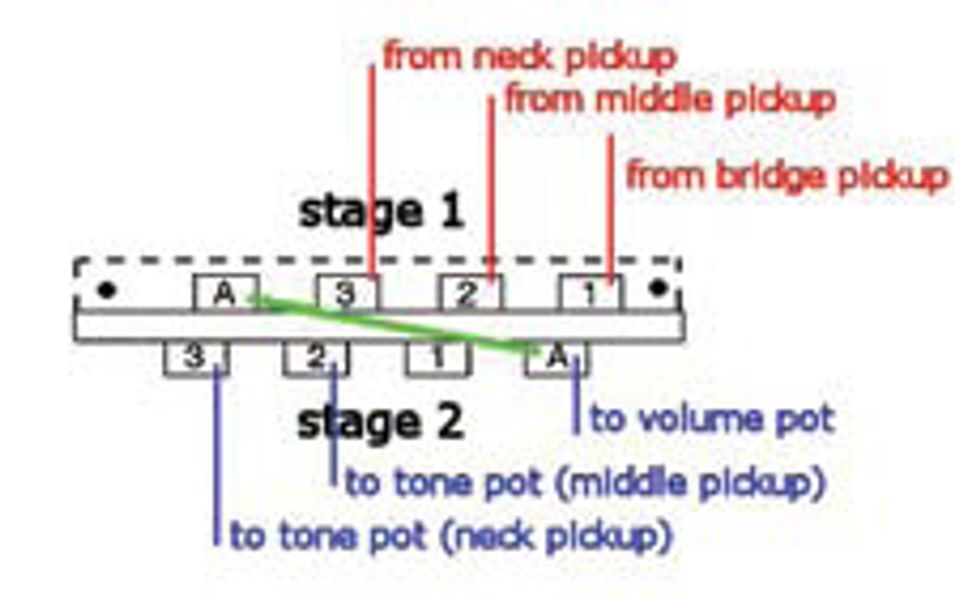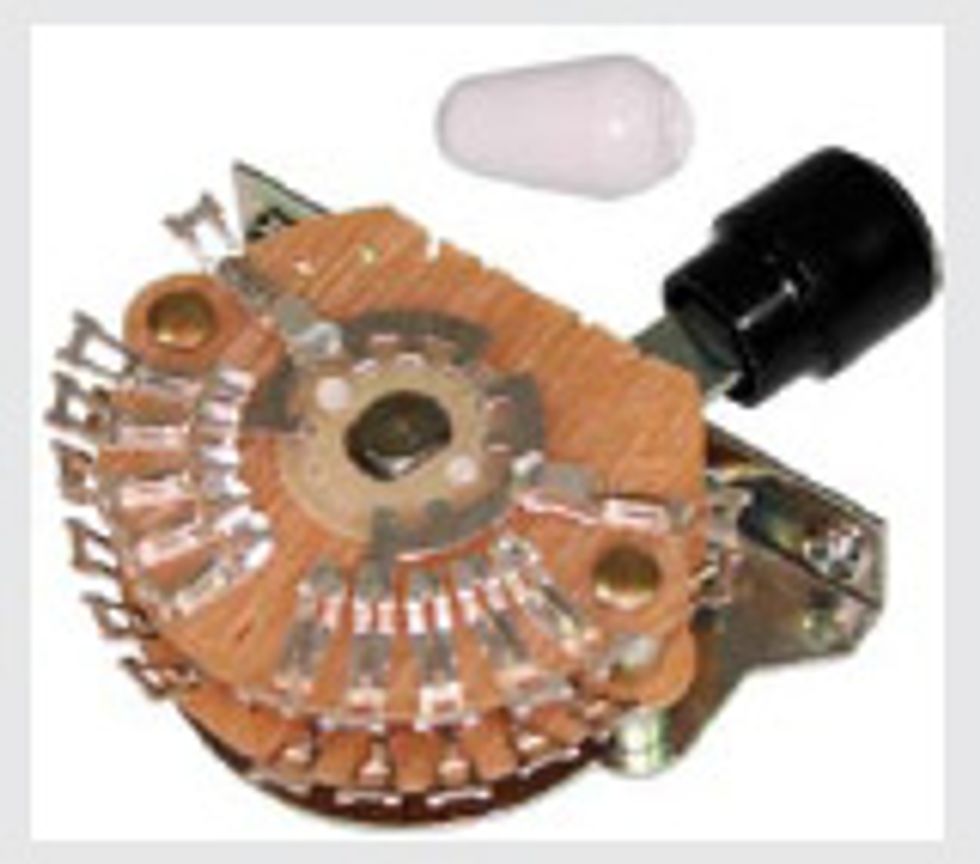Instead of two stages, this switch offers four completely independent stages with six terminals each, yielding a total of 24 terminals!
Last month, we took a crash
course in guitar switches—an essential step for anyone
serious about hot-rodding
guitars [“The ABCs of Guitar Switches," August 2011]. If
you missed this column, or just
want a quick review, take a moment to check it out.
Additionally, you might find it
useful to revisit my three-part
series on Fender 5-way switches [“The Anatomy of the Stratocaster 5-Way Switch, Parts 1-3," February, March, and April 2009].

Okay, ready for some more
switching lore? Before we venture
into new realms, let's review
what we know: A normal 5-way
pickup selector has two stages (or
rows), each of which is equipped
with four soldering lugs.

Stage 1 is also called the
“input stage," while stage 2 is
the “output stage." In a nutshell,
you have hot wires from
the pickups that are going into
the switch (stage 1, lugs 1+2+3),
and a hot wire that goes out of
the switch (stage 2, lug A) and
to the volume pot. From there,
the signal goes to the tone pots
and then on to the output jack.
So, each stage of the switch has
three inputs (lugs 1+2+3) and
one output (lug A). Check out
the following diagram of standard
Stratocaster wiring.

The standard 5-way switch
offers lots of options. But when
your wiring gets complex and
you start integrating out-of-phase
wiring, series/parallel
switching, coil-splitting, and
the like, you soon discover
you need additional switching
devices, such as mini toggles or
push/pull pots to make these
schemes work.
That's exactly why the
“5-way super switch" was
invented. Instead of two stages,
this switch offers four completely
independent stages with six
terminals each, yielding a total
of 24 terminals! This makes
additional switching devices
more or less obsolete, because
all you need is already there in
the switch itself. This switch
is also often called a “4-pole
switch," “double-wafer switch,"
or “double-throw switch." But
all these terms mean the same
thing: Technically, you have a
24-lug, 4-pole/5-throw switch
(aka 4P5T).
Fender sells an open-frame
version of this 4P5T switch,
which, as you can see below, has
a construction that's similar to a
standard 5-way switch.

The German company EYB
also makes a PCB-based version
of the switch called the
double-wafer M4 Megaswitch.
(Incidentally, if you know who
first invented this 4P5T switch,
please drop me an email. I'd like
to give credit where it's due.)
If you think this is a monster
of a switch (which it really is),
be prepared for even more: EYB
also offers a stacked version
of their M4 Megaswitch with
eight (!) instead of four stages
(aka 8P5T). If you have a lot of
time on your hands and want to
explore the world of unlimited
switching possibilities, this one
will keep you busy for several
weeks. Or years.
Because you can use a super
switch as a standard 5-way
switch and still have so many
options for future mods, installing
one seems like a no-brainer.
But there are also two downsides
to this slick bit of technology
that I need to mention.
First, a super switch is
physically much larger than
a standard switch. Installing
one in certain guitars—like a
Telecaster—poses massive problems.
Sometimes the only way
to make them fit is by routing
out your electronic compartment.
To avoid any unpleasant
surprises, always double-check
the dimensions of both the
switch and cavity before you
make your purchase.
To accommodate the open
Fender switch, you need at least
21 mm of space surrounding
it. Allowing 25 mm helps avoid
any problems with the soldering
terminals. At this point, I've only
used the stacked 8-pole version
from EYB in one guitar. I can
tell you it was really a challenge
to make it fit, even in a Strat.
Second, super switches aren't
very well documented, and you'll
only find a few wiring diagrams
on the internet. This is because
they've only become available in
recent years, and they're much
more complicated to work with
than the standard 5-way switch.
So if you're looking for a lot of
“paint-by-numbers" diagrams,
you will be disappointed. It's
crucial to understand the basics
of this switch so you can develop
your own mods and switching
schemes. You simply can't depend
on anyone else's diagrams.
Stay tuned for the second
installment of our 5-way super
switch series, in which we discuss
the technical side of this beast and
how to wire it up. I'll show you
an easy-to-understand switching
matrix you can use as a template
to develop your own super-switch
mods. See you then!
Dirk Wacker lives in
Germany and is fascinated
by anything related to old
Fender guitars and amps.
He plays country, rockabilly,
and surf music in two
bands, works regularly as a
session musician for a local studio, and writes
for several guitar mags. He's also a hardcore
guitar and amp DIY-er who runs an extensive
website—singlecoil.com—on the subject.


